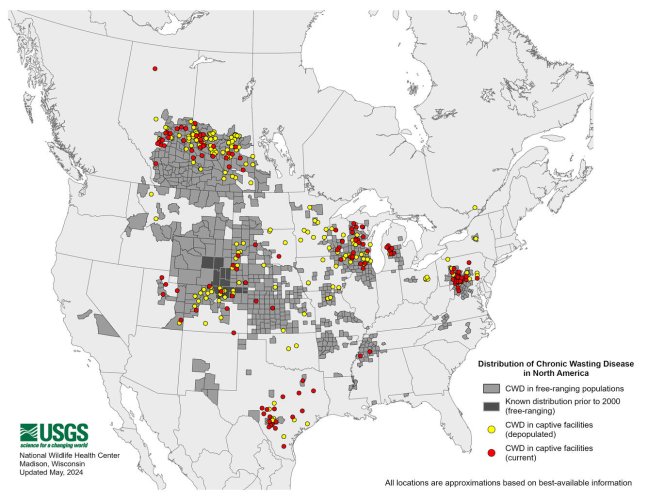Navigation
Install the app
How to install the app on iOS
Follow along with the video below to see how to install our site as a web app on your home screen.
Note: This feature may not be available in some browsers.
More options
You are using an out of date browser. It may not display this or other websites correctly.
You should upgrade or use an alternative browser.
You should upgrade or use an alternative browser.
CWD Confirmed in California Deer Population
- Thread starter Laszlo Cravensworth
- Start date
WYelker
Well-known member
- Joined
- Feb 1, 2021
- Messages
- 488
But they have all those pr factors and predators are supposed to stop it…
Schaaf
Well-known member
Kinda shocking CWD was able to find one of the seven deer in that state.
lastlight
Well-known member
Saw this the other day. It only makes sense that it’s been on the landscape since forever then.
brocksw
Well-known member
It would not surprise me to learn that there were some random sporadic cases that pop up in cervid species here and there. But keep in mind that there has not been a single sporadic case found in deer or elk to date. These cases in California are the first found in over 20 years of testing.Saw this the other day. It only makes sense that it’s been on the landscape since forever then.
Nick87
Well-known member
Can you elaborate on that?It would not surprise me to learn that there were some random sporadic cases that pop up in cervid species here and there. But keep in mind that there has not been a single sporadic case found in deer or elk to date. These cases in California are the first found in over 20 years of testing.
brocksw
Well-known member
With sheep there was 2 different kinds of scrapie, "classical" and "atypical". The atypical is a sporadic or spontaneous form of this disease. Meaning there is no infection source (that we know of) so to speak, it just sporadically appears in the sheep population. Atypical scrapie also manifests itself differently in the individual animal. That is to say that the prions collect in different areas of the body at different densities, meaning sometimes they elude testing. These animals weren't shedding nearly as many infectious prions through saliva, urine, feces. edit: there's still some debate about how contagious atypical scrapie is, but it's likely not as contagious as classical scrapie.Can you elaborate on that?
This spontaneous form of a TSE is also the most popular type of Creutzfeldt-Jakobs Disease, or "sporadic CJD", in humans. Where we see a few hundred cases every year, globally.
I believe they've found two moose in Europe that they believe had a sporadic form of CWD. But there's still some debate out there about what that means in cervids and whether or not they can confirm this as "sporadic". I believe these would be the first two cervids, globally, that potentially had this sporadic form of the disease.

Sporadic cases of chronic wasting disease in old moose - an epidemiological study - PubMed
Transmissible spongiform encephalopathies or prion diseases comprise diseases with different levels of contagiousness under natural conditions. The hypothesis has been raised that the chronic wasting disease (CWD) cases detected in Nordic moose (<i>Alces alces</i>) may be less contagious, or not...
Some noteworthy context to this discussion. There is a difference between what's being proposed with this genetic program in sheep and deer. They've been able to drastically reduce scrapie in domestic sheep using the same selective breeding for heritable traits strategy that the article above talks about. This work in white tailed deer is work done by a number of scientists, but Dr. Chris Seabury is the most notable. However, in sheep they found a phenotype that was basically completely resistant to scrapie. That is not the case with deer, only less susceptible phenotypes. They still get positives once in a while in sheep. And when they do, they cull the heard and pay the owner indemnity money. How is that going to be possible with a wild deer herd?
Some research on the topic of scrapie:
By Justin Greenlee
Transmission characteristics

Experimental Oral Transmission of Atypical Scrapie to Sheep
Such transmission results in peripheral tissue infectivity that is not detectable by current surveillance screening methods.To investigate the possibility of oral transmission of atypical scrapie in sheep and determine the distribution of infectivity ...
Overview

Classical and Atypical Scrapie in Sheep and Goats. Review on the Etiology, Genetic Factors, Pathogenesis, Diagnosis, and Control Measures of Both Diseases
Classical scrapie is a prionic, neurological, consumptive, and chronic disease that affects naturally domestic small ruminants. It was initially described in the UK, and since then it has spread throughout the world. Atypical scrapie was first diagnosed ...
Last edited:
lastlight
Well-known member
So do you think it just showed up recently in CA? How? Naturally or transported carcass from out of state?
I used to live and hunt in the sierras and the coast. F&G only ask the last two years for samples only out of DZones. Never was asked in the early to later 2000s. No friends of family have ever test their bucks in CA and hunt all over. I’d be curious how many samples they get yearly and since when exactly.
Also keep in mind, CA DFG puts deer at the very bottom of their list of concerns/resources. Its marine life, predators, threatened species, endangered, cannabis, field mice, then maybe deer if they have some pennies left over. They are so hamstrung by groups like Center for Biological diversity.
I used to live and hunt in the sierras and the coast. F&G only ask the last two years for samples only out of DZones. Never was asked in the early to later 2000s. No friends of family have ever test their bucks in CA and hunt all over. I’d be curious how many samples they get yearly and since when exactly.
Also keep in mind, CA DFG puts deer at the very bottom of their list of concerns/resources. Its marine life, predators, threatened species, endangered, cannabis, field mice, then maybe deer if they have some pennies left over. They are so hamstrung by groups like Center for Biological diversity.
brocksw
Well-known member
California has tested over 6000 animals since the early 2000s IIRC. Don't quote me on that.So do you think it just showed up recently in CA? How? Naturally or transported carcass from out of state?
I used to live and hunt in the sierras and the coast. F&G only ask the last two years for samples only out of DZones. Never was asked in the early to later 2000s. No friends of family have ever test their bucks in CA and hunt all over. I’d be curious how many samples they get yearly and since when exactly.
Also keep in mind, CA DFG puts deer at the very bottom of their list of concerns/resources. Its marine life, predators, threatened species, endangered, cannabis, field mice, then maybe deer if they have some pennies left over. They are so hamstrung by groups like Center for Biological diversity.
But to your question, I can't say for sure. Could have been infectious material transported to CA by other vectors. For example humans could've dumped a positive carcass from another state near this location. Could've been that positive deer have escaped detection in Nevada and the disease has migrated into CA. I'd say it's unlikely both of these positives are sporadic cases.
But again, my understanding is that if there was a sporadic case in deer, there is a potential that prions would not accumulate in the lymph nodes, and therefore would go undetected by the standard testing procedures being used by hunters and state agencies where laryngeal lymph nodes are the standard testing material.
Laszlo Cravensworth
Well-known member
So do you think it just showed up recently in CA? How? Naturally or transported carcass from out of state?
I used to live and hunt in the sierras and the coast. F&G only ask the last two years for samples only out of DZones. Never was asked in the early to later 2000s. No friends of family have ever test their bucks in CA and hunt all over. I’d be curious how many samples they get yearly and since when exactly.
Also keep in mind, CA DFG puts deer at the very bottom of their list of concerns/resources. Its marine life, predators, threatened species, endangered, cannabis, field mice, then maybe deer if they have some pennies left over. They are so hamstrung by groups like Center for Biological diversity.
Similar threads
- Replies
- 15
- Views
- 3K







